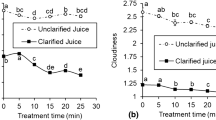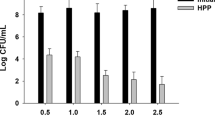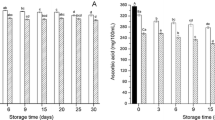Abstract
This work studied the effectiveness of gaseous ozone disinfection on pummelo (Citrus Grandis L. Osbeck) fruit juice components. Unfiltered and filtered pummelo fruit juices were treated with gaseous ozone for up to 50 min with ozone concentration fixed at 600 mg/h. A microbiological and physicochemical properties analysis were conducted on the ozone-treated fruit juices samples. It was found that the survival rate of aerobic bacteria, yeast and mold in unfiltered pummelo fruit juice were higher compared to filtered juice, as the juice components acted as protective barriers to the microorganisms. The microorganisms’ inactivation in pummelo fruit juices was also observed to have increased as the ozone treatment time increased. Significant effects on total colour difference, ascorbic acid content, and total phenolic content were also observed over increased ozone-treatment time. However, ozone was shown to be ineffective in activating PME activity in both types of juice. The experimental results of this study indicated that pummelo fruit juice components had significant effects on the effectiveness of gaseous ozone, however, the degree of the effects depends on the different fruit components (total soluble solids, total phenolic content). As a conclusion, filtered juice showed better quality characteristics in comparison to unfiltered juice post-ozone treatment.





Similar content being viewed by others
References
Alothman M, Kaur B, Fazilah A, Bhat R, Karim AA (2010) Ozone-induced changes of antioxidant capacity of fresh-cut tropical fruits. Innov Food Sci Emerg Technol 11(4):666–671
Al-Zubaidy MMI, Khalil RA (2007) Kinetic and prediction studies of ascorbic acid degradation in normal and concentrate local lemon juice during storage. Food Chem 101(1):254–259
Amador JR (2011) Juice analysis: ascorbic acid by indophenol titration. In: Amador JR (ed) Laboratory manual: procedures for analysis of citrus products, 6th edn. John Bean Technology Corporation Inc., Chicago, pp 82–84
Angelino PD, Golden A, Mount JR (2003) Effect of ozone treatment on quality of orange juice. In: IFT annual meeting book of abstracts. Chicago, IL
Barbosa-Canovas GV, Bermudez-Aguirre D (2011) Why nonthermal technologies. In: Zhang HQ, Barbosa-Cánovas GV, Balasubramaniam VM, Dunne CP, Farkas DF, Yuan JTC (eds) Nonthermal processing technologies for food. Wiley, Chichester
Croak S, Corredig M (2006) The role of pectin in orange juice stabilization: effect of pectin methylesterase and pectinase activity on the size of cloud particles. Food Hydrocol 20:961–965
Cullen PJ, Valdramidis VP, Tiwari BK, Patil S, Bourke P, O’Donnell CP (2010) Ozone processing for food preservation: an overview on fruit juice treatments. Ozone Sci Eng 32(3):166–179
DOA (2012) Department of Agriculture Malaysia, Pomelo: Varieties/clones. http://www.doa.gov.my/main.php?Content=sections&SubSectioID=390&SectionID=5&CurLocation=315&IID=. Accessed 9 June 2012
FDA (2004) Juice HACCP: hazards and controls guidance, guidance for industry, 1st edn. Division of Plant Product Safety
Guzel-Seydim ZB, Greene AK, Seydim AC (2004) Use of ozone in food industry. Lebensm Wiss Technol Food Sci Technol 37(4):453–460
Khadre MA, Yousef AE, Kim J (2001) Microbiological aspects of ozone applications in food: a review. J Food Sci 66(9):1242–1252
Kim JG, Yousef AE, Khadre MA (2003) Ozone and its current and future application in the food industry. Adv Food Nutr Res 45:167–218
Kimball D (1999) Citrus processing. A complete guide, 2nd edn. Kluwer Academic, New York
Kumar D, Antonius H, Lamers H, International B, Ratna B, Bioversity S (2015) Phytochemical evaluation of pummelo fruits (Citrus grandis) in India for enhancing marketing opportunities. Indian J Plant Genetic Resour 28:50–54
Maturin L, Peeler JT (2001) Aerobic plate count. In: Bacteriological analytical manual, 8th edn, pp 1–9. https://www.fda.gov/Food/FoodScienceResearch/LaboratoryMethods/ucm063346.htm. Accessed 30 Oct 2016
Moore G, Griffith C, Peters A (2000) Bactericidal properties of ozone and its potential application as a terminal disinfectant. J Food Prot 63(8):1100–1106
Patil S (2010) Efficacy of ozone and ultrasound for microbial reduction in fruit juice. Doctoral Dissertation. Dublin Institute of Technology. http://arrow.dit.ie/sciendoc. Accessed 15 Feb 2017
Patil S, Bourke P (2012) Ozone processing of fluid foods. In: Novel thermal and non-thermal technologies for fluid foods. Elsevier, pp 225–261
Patil S, Bourke P, Frias JM, Tiwari BK, Cullen PJ (2009) Inactivation of Escherichia coli in orange juice using ozone. Innov Food Sci Emerg Technol 10(4):551–557
Rawson A, Patras A, Tiwari BK, Noci F, Koutchma T, Brunton N (2011) Effect of thermal and non thermal processing technologies on the bioactive content of exotic fruits and their products: review of recent advances. Food Res Int 44(7):1875–1887
Restaino L, Frampton EW, Hemphill JB (1995) Efficacy of ozonated water against various food-related microorganisms. Appl Environ Microbiol 61(9):3471–3475
Rodoni L, Vicente AR (2010) Effect of short-term ozone treatments on tomato (Solanum lycopersicum L.) fruit quality and cell wall degradation. J Agric Food Chem 58(December):594–599
Shah NNAK, Rahman RA, Shamsudin R, Adzahan NM (2015) Effects of pectinase clarification treatment on phenolic compounds of pummelo (Citrus grandis L. Osbeck) fruit juice. J Food Sci Technol Mysore 52(8):5057–5065
Ting SV, Huggart RL, Ismail MA (1980) Color and processing characteristics of Star Ruby grapefruit. Proc Fla State Hortic Soc 93:293–295
Tiwari BK, Muthukumarappan K (2012) Ozone in fruit and vegetable processing. In: O'Donnell C, Tiwari BK, Cullen PJ, Rice RG (eds) Ozone in food processing, 1st edn. Wiley, Chichester, pp 55–74
Tiwari BK, Muthukumarappan K, O’Donnell CP, Cullen PJ (2008a) Modelling colour degradation of orange juice by ozone treatment using response surface methodology. J Food Eng 88(4):553–560
Tiwari BK, Muthukumarappan K, O’Donnell CP, Cullen PJ (2008b) Kinetics of freshly squeezed orange juice quality changes during ozone processing. J Agric Food Chem 56(15):6416–6422
Tiwari BK, O’Donnell CP, Muthukumarappan K, Cullen PJ (2009a) Anthocyanin and colour degradation in ozone treated blackberry juice. Innov Food Sci Emerg Technol 10(1):70–75
Tiwari BK, O’Donnell CP, Patras A, Brunton N, Cullen PJ (2009b) Anthocyanins and color degradation in ozonated grape juice. Food Chem Toxicol 47(11):2824–2829
Torlak E (2014) Efficacy of ozone against Alicyclobacillus acidoterrestris spores in apple juice. Int J Food Microbiol 172:1–4
Torres B, Tiwari BK, Patras A, Wijngaard HH, Brunton N, Cullen PJ, Donnell CPO (2011) Effect of ozone processing on the colour, rheological properties and phenolic content of apple juice. Food Chem 124(3):721–726
Van Boekel M (2002) On the use of the Weibull model to describe thermal inactivation of microbial vegetative cells. Int J Food Microbiol 74(1):139–159
Williams RC, Sumner SS, Golden DA (2004) Survival of Escherichia coli O157:H7 and Salmonella in apple cider and orange juice as affected by ozone and treatment temperature. J Food Prot 67(11):2381–2386
Yeoh WK, Ali A, Forney CF (2014) Effects of ozone on major antioxidants and microbial populations of fresh-cut papaya. Postharvest Biol Technol 89:56–58
Acknowledgements
The authors would like to acknowledge the financial support provided by Universiti Putra Malaysia under the IPM Grant No. 9491300.
Author information
Authors and Affiliations
Corresponding author
Rights and permissions
About this article
Cite this article
Shah, N.N.A.K., Supian, N.A.M. & Hussein, N.A. Disinfectant of pummelo (Citrus Grandis L. Osbeck) fruit juice using gaseous ozone. J Food Sci Technol 56, 262–272 (2019). https://doi.org/10.1007/s13197-018-3486-2
Revised:
Accepted:
Published:
Issue Date:
DOI: https://doi.org/10.1007/s13197-018-3486-2




